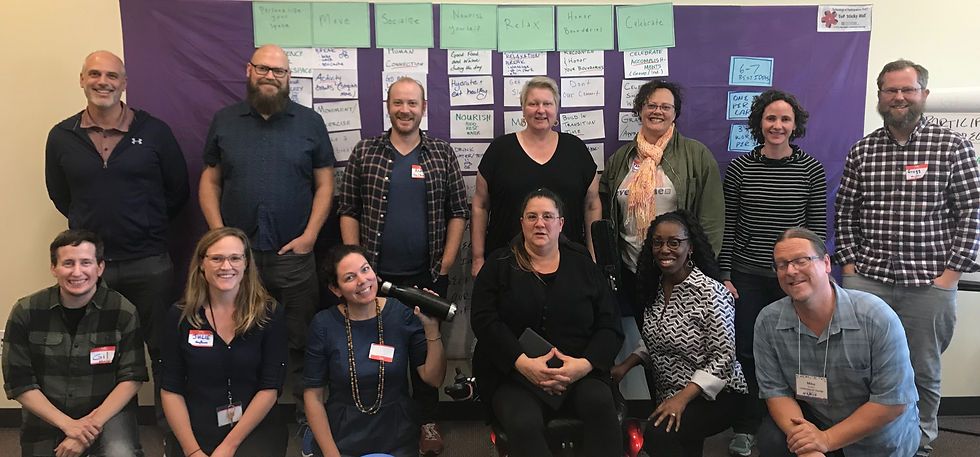I Took a ToP Course. Now What?
- Sherry P. Johnson

- Jul 4, 2023
- 3 min read
Updated: Dec 25, 2024

I've trained many people in how to use Technology of Participation (ToP)™ methods, but I often see participants struggle to remember when to use which method. The two-day training is jam-packed, and the three-day isn't much lighter. Plus, the real world is full of ambiguity, so I thought it might be helpful to unpack my “ideal groups” for each of ToP™’s foundational methods, PLUS share another couple groups who really need something else entirely.
Before I start, though: No group will ever fit perfectly into these profiles, and ToP™ approaches are greatly enriched in combination with other methods. A good design conference can go a long way to help insure successful fit, and the more you facilitate, the more you can mix, match, and—my favorite—break rules. Everything here is for in-person engagement, but I'll revisit this for online contexts.
Ideal Groups for each In-Person ToP Foundational Method
The Focused Conversation Group of My Dreams
This group of 8-12 folks is ready to share thoughts on a clearly defined topic. They represent a broad array of perspectives. Everyone who has information to share is in the space, or there’s a plan to include them. The group’s cultural context values different ways of learning and expressing information, including linear and narrative styles. At least 2 people from the group have helped define aims beforehand, and they have scheduled 30-45 minutes for focused engagement around those aims. They’ve also reserved a space that feels warm and has decorative elements that complement the tone of the topic. Finally, any outside authority has already defined how the group’s resolve will be incorporated into the larger context: in short, the group knows the shape of their power.
The Consensus Workshop Group of My Dreams
This group of 15-35 folks is ready for a focused approach to a complicated issue in need of new ideas. They represent a broad array of interests around the topic—but not so many that they don't share a common set of values. Everyone who will be affected by the workshop results is represented in the space, or there’s a plan to include them. The group’s cultural context values openness and creativity. At least 2 people from the group have helped define the topic and aims beforehand, and they have set aside at least 90 minutes for focused engagement around those aims. They’ve also reserved a space that feels warm and has decorative elements that complement the tone of the topic. Finally, any outside authority has already defined how the group’s resolve will be incorporated into the larger context: again, the group knows the shape of its power.
The Easel Consensus Workshop Group of My Dreams
Everything above, but you’ve only got 6 months and 4-10 “do-ers.”
The Action Planning Group of My Dreams
This group of 15-35 folks is ready for a focused approach to planning an event or short-term project they’ve already agreed upon. Ideally, they’re focusing on something that hasn’t been done before or is in need of an overhaul. That said, whatever's involved has fairly predictable outcomes. Participants represent a broad array of abilities related to the plan. All the “do-ers” are in the room; in fact, there aren’t any “bystanders” or “advisors” who plan to leave after the planning session. The group’s cultural context values the wisdom of the group. They have set aside 3 hours or more for large- and small-group planning. They’ve reserved a space that encourages focus, with good spaces for breaking into small groups. Finally, any outside authority has already weighed in on the plan’s governing constraints, in terms of legal or financial implications. This group needs a lot of freedom and power within those constraints.
The Accelerated Action Planning Group of My Dreams
Everything above, but you’ve only got 6 months and 4-10 “do-ers.”
Two words of caution
When applying ToP™: If a group has significantly different perspectives around a topic—particularly where significant power dynamics are present—I advocate for caucusing beforehand so that minority viewpoints aren't stifled or erased. Also, where conflict is present, I recommend applying methods such as the ToP™ Focused Conversation, Narrative Mediation, Convergent Facilitation, or restorative practices like The Circle Way before applying a Consensus Workshop or Action Plan.
Want to learn more about these methods or spread these skills throughout your organization? Contact us. We offer trainings across Minnesota and with affiliate partners in Wisconsin and Washington states.




Comments